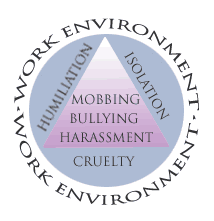From the Introduction:
Joan began having episodes of uncontrollable crying, and for the first time in her life, had anti-anxiety medication prescribed by her physician. A seasoned administrator, she had for months been forced to make decisions without complete information. Her decisions were then questioned or overturned. She was also forced to attend meetings where she was totally ignored. Unrealistic deadlines and a dramatically increased workload overwhelmed her. Furthermore, others in the organization undermined her authority. She resigned with a negotiated settlement.
Sean, an experienced tradesman in a service organization, was excluded from meetings and cut off from information necessary to perform his job effectively. He was subjected to constant insults and his work was belittled. He was also forced to perform hazardous tasks without assistance, while supervisors or others watched. Soon after, he suffered a heart attack while on the job. Considered recovered, he returned to his job. He was fired soon after. He filed for unemployment compensation which was denied, appealed and finally granted.
With more than 30 years of experience in management, Ron was a successful project leader in a high-tech company. A major project brought almost to fruition, Ron was suddenly relieved of his staff and responsibilities. His new supervisor began to assume full credit for his work. Isolated at a small desk in a corner, Ron no longer was included in any meetings or discussions, even though he knew more about the project than anyone else. After a few months, he was found wandering the streets. Blood was streaming down his face–he had just walked into a wall. Weeks later, following an emotional meeting with his superior–“I remained very calm,” Ron recalled–he suffered a heart attack as he walked back to his desk. Following by-pass surgery, he went on disability and was unable ever to return to work.
Like Ron, Jean, and Sean, every year, millions of Americans become victims of emotional abuse inflicted at work. They are damaged to such an extent that they can no longer accomplish their tasks. Coworkers, colleagues, superiors and subordinates attack their dignity, integrity and competence, repeatedly, over a number of weeks, months, or years. At the end, they resign–voluntarily or involuntarily–are terminated, or forced into early retirement. This is mobbing–workplace expulsion through emotional abuse.
Ironically and sadly, the victims are portrayed as the ones at fault, as the ones who brought about their own downfalls. Mind you, Ron, Jean and Sean, were not people who had a reputation of not performing well, not meeting organizational standards, or who could not get along with others. They were qualified. They had contributed their talents to the organization. They had been in the organization for a number of years.
How, you might ask, when there seem to be more structures and laws designed to protect workers than ever before, is this particular workplace behavior–mobbing–allowed to exist? There are three reasons.
One is that mobbing behaviors are ignored, tolerated, misinterpreted or actually instigated by the company or the organization’s management as a deliberate strategy. The second reason is that this behavior has not yet been identified as a workplace behavior clearly different from sexual harassment or discrimination. Thirdly, more often than not, the victims are worn down, feel destroyed and exhausted. They feel incapable of defending themselves, let alone initiating legal action.
From Chapter 1:
Mobbing is an emotional assault. It begins when an individual becomes the target of disrespectful and harmful behavior. Through innuendo, rumors, and public discrediting, a hostile environment is created in which one individual gathers others to willingly, or unwillingly, participate in continuous malevolent actions to force a person out of the workplace.
These actions escalate into abusive and terrorizing behavior. The victim feels increasingly helpless when the organization does not put a stop to the behavior or may even plan or condone it.
As a result, the individual experiences increasing distress, illness, and social misery. Frequently, productivity is affected, and victims begin to use sick leave to try to recover from the daily pressures and torment. Depression or accidents may occur. Resignation, termination, or early retirement–the negotiated voluntary or involuntary expulsion from the workplace–follows.
For the victim, death–through illness or suicide–may be the final chapter in the mobbing story.
For the organization, mobbing is like cancer. Beginning with one malignant cell, it can spread quickly, destroying vital elements of the organization. Remedial action must be taken at an early stage.
Mobbing is aggression against anyone–rather than specific discrimination against someone based on age, gender, race, creed, nationality, disability or pregnancy–using harassing, abusive and often terrorizing behaviors. Mobbing is done intentionally to force the person out of the workplace.
Two different types of such malevolent conduct can be identified: Active aggression and passive aggression. These tactics vary according to the subtlety of the aggressor. Passive aggressives are a special problem, since they can wrap their malevolence in acts of occasional kindness and politeness.
The psychological consequences of mobbing should be termed an injury not an illness, thus attributing the cause of the suffering to the persons who intentionally inflicted the harm. (Endnote: Tim Field in his book Bully in Sight also insists on the term injury.)
Dr. Heinz Leymann identified 45 mobbing behaviors and grouped them in five different categories, depending on the nature of the behavior. Not all of these will happen in every case.





